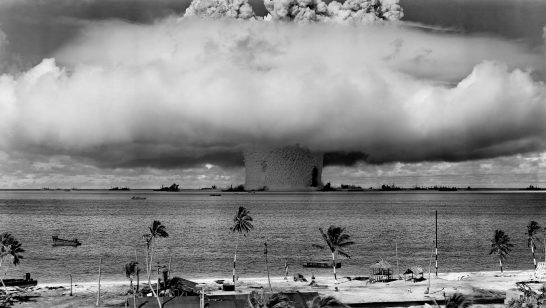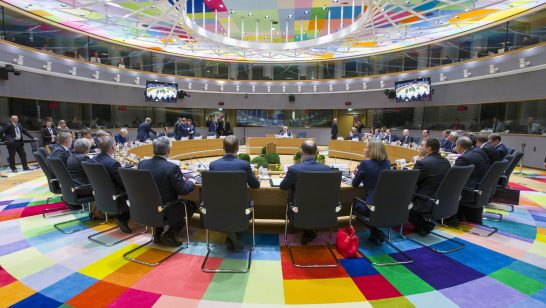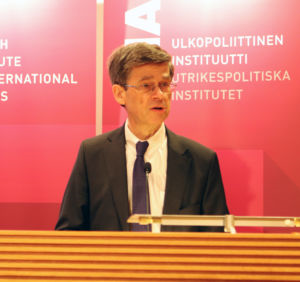
The last preparatory committee meeting (PrepCom) before the 2020 Review Conference (RevCon) of the 1968 Treaty on the Non-Proliferation of Nuclear Weapons (NPT) will be held in New York from 29 April to 10 May 2019. In accordance with the decisions taken when the NPT was indefinitely extended in 1995, the PrepComs are intended to consider “principles, objectives and ways in order to promote the full implementation of the Treaty, as well as its universality, and to make recommendations” for the next RevCon to decide on.
What, then, can we expect from the 2019 PrepCom? Judging from the 2017 and 2018 meetings, the major challenges for the NPT-based regime will come from real-world nuclear developments, NPT-related issues that are freighted with historic and procedural significance (or baggage), and the proliferation policies of nuclear-armed states. While related, these should not be conflated.
Tasked especially with reviewing developments since the 2015 RevCon, the major issues of disagreement will include:
- How to reinforce the existing legal regime underpinning the NPT, especially in light of US and Russian nuclear weapons enhancement programmes and their pending withdrawal from the 1987 Intermediate-Range Nuclear Forces (INF) Treaty;
- The Trump administration’s rejection of the 2015 Joint Comprehensive Programme of Action (JCPOA) with Iran, and related impacts on non-proliferation;
- The humanitarian-based 2017 Treaty on the Prohibition of Nuclear Weapons (TPNW aka the Ban Treaty), negotiated and adopted by two-thirds of the UN General Assembly but boycotted by the nuclear-armed states and some of their allies;
- Ways to kick-start negotiations on a nuclear weapon free zone (NWFZ) and/or zone free of all weapons of mass destruction (WMD) in the Middle East, where progress has stalled despite high-level commitments in 1995 and 2010;
In addition, expect to see much lip service but little practical action on:
- Bringing the Comprehensive Test Ban Treaty (CTBT) into force and ending fissile materials production and stockpiling;
- Nuclear and missile tests by the Democratic People’s Republic of Korea (DPRK aka North Korea), recent efforts towards denuclearising the Korean Peninsula, and the importance of ensuring compliance with all relevant treaties;
- Nuclear safety issues, as well as broader nuclear energy concerns, as they relate to proliferation and preventing serious accidents such as Chernobyl and Fukushima;
- Nuclear security provisions and calls for stronger safeguards and greater uptake of the IAEA’s additional protocol.
Contributing to the pressures, the Treaty has to be reviewed, taking into account that fifty years since the NPT entered into force, there are over 14,000 nuclear weapons in the hands of nine nuclear-armed states, who are either not Treaty parties or else defined in the text as “nuclear weapon states” (the “NPT5”, who are also “P5” permanent members of the UN Security Council). The four outside the Treaty are not legally constrained and, indeed, derive security benefits from the constraints applied to their neighbours. The NPT5 cloak themselves in their NPT status while justifying their nuclear enhancement programmes. Both groups are eroding the NPT’s credibility as an effective mechanism for disarmament and non-proliferation.
The major areas of contention in 2019, as in most NPT meetings, will centre on nuclear disarmament and the Middle East. In an effort to provide “an output-focused outlook”, the Chairs of the first two PrepComs – Netherlands Ambassador Henk Cor van der Kvast and Poland’s Ambassador Adam Bugajski – have already submitted an “Inter-Chair Working Paper”. There is much in this that can be broadly supported, but that won’t necessarily help the Chair of the 2019 PrepCom, Malaysia’s Ambassador Syed Md Hasrin Syed Hussin. The geostrategic objectives and relations among nuclear-armed nations and a handful of Middle East governments will, as in previous meetings, dominate the PrepCom, so we need to look more carefully at what is being papered over in the Inter-Chair document.
Nuclear Disarmament
In many ways, the most important development since 2015 is the TPNW, which was taken forward by means of a humanitarian disarmament process launched at the 2010 NPT RevCon and finalised as a “nuclear ban treaty” through political and diplomatic initiatives that culminated in negotiations under UN auspices. At the NPT’s 2018 PrepCom, the first after the TPNW was opened for signature by the UN Secretary-General on 20 September 2017, an interesting dynamic developed. A few of the nuclear-armed governments and allies seemed bent on making the TPNW into a central problem for the NPT, while TPNW signatories such as Austria and various members of the Non-Aligned Movement (NAM) were at pains to avoid conflict and emphasise the humanitarian imperative to work on mutually reinforcing approaches for nuclear disarmament. Caught between strong civil society pressure to join the TPNW and countervailing pressures to maintain nuclear use arrangements, Japan hopes to revive “bridge-building” steps formerly adopted by the 2000 NPT RevCon.
From 2010 to 2017 the humanitarian ban treaty initiatives were underestimated, and now that the TPNW exists, this sidelining pattern is being continued by NATO diplomats. When Bugajski presented his draft Chair’s summary in 2018, one paragraph purported to summarise the many positive statements about the TPNW in these terms: “A number of states parties informed about the ratification and status of this treaty. It was asserted that the TPNW represented an effective measure under Article VI of the NPT by creating a legally binding prohibition of nuclear weapons. It was stressed that the TPNW complemented the NPT and was designed to strengthen existing disarmament and nuclear non-proliferation regimes.”
Although far fewer states opposed the TPNW, the text and tone of the following paragraph gave their views greater weight and significance: “Other states parties expressed their opposition to the TPNW, emphasizing the crucial link between progress on disarmament and the international security environment. It was asserted that the TPNW would not contribute to the reduction or limitation of nuclear weapons. These states noted that the TPNW does not reflect customary international law and thus could bind only its signatories. Concerns were expressed that the TPNW could create an alternative and contrary standard to the NPT.”
Though dismayed that Bugajski’s summary was so dismissive of the TPNW, the majority were conscious of the need to avoid playing into the hands of those wanting to portray the TPNW as a problem for the NPT regime. Not wanting to divert attention from the problematic policies and actions of the nuclear-armed and proliferating states, most TPNW signatories carefully calibrated their responses to avoid providing ammunition that might be used to harm either the NPT or TPNW in the future.
Their strategy is to consolidate the TPNW as a constructive addition to the disarmament and non-proliferation toolkit and engage in practical consideration of next steps. They are conscious of the need to keep providing reassurance that the TPNW is a separate but helpful legal instrument that will strengthen the regime. Amongst themselves, TPNW signatories are considering how best to develop the legal, technical and verification frameworks to implement the Ban Treaty’s provisions and accelerate the elimination of nuclear arsenals. With 70 signatories and 23 ratifications at time of writing, this treaty is almost halfway to meeting its entry-into-force requirements. Notably, more NPT member states (122) participated in negotiations and voted positively to adopt the finalised TPNW in 2017 than the 105-111 NPT parties registered in the first two NPT PrepComs.
Turning to the positions of the NPT5, we find Washington rehashing an old concept, “creating the conditions for nuclear disarmament” (CCND). Spearheaded by Christopher Ford, US Assistant Secretary for International Security and Nonproliferation, and now renamed “creating the environment for nuclear disarmament” (CEND), this academically framed approach seeks to put the onus of nuclear disarmament and security responsibility mainly on non-nuclear NPT parties and “some nuclear-weapon states”, while ignoring or justifying the treaty-undermining and proliferation activities of the United States. Russia’s defensive response is a new working paper titled “Nuclear Disarmament” which mainly blames US military-nuclear policies. It also sideswipes the TPNW, calling it “premature” and insisting that at present “possession of nuclear weapons is a necessity and the only possible response to very specific external threats”.
US-Russian exchanges in 2019 may be sharper and more adversarial than usual. Even it these are mainly posturing, the increased emphasis on nuclear weapons and threats are contributing to increased risks and dangers. Both countries are committed to some aspects of nuclear security, but have even louder vested interests in maintaining and enhancing their nuclear arsenals. Despite support from France and the UK, it is unlikely that the NPT5 will manage any joint initiatives. Even a lowest common denominator statement will be a stretch in 2019, unless it is one that has no relevance to real-world nuclear challenges but serves as a lip-service mechanism with the underlying purpose of maintaining NPT-based privileges for the nuclear-armed P5.
France and the UK will no doubt continue in their efforts to undermine the TPNW inside and outside the NPT, but they are relatively weak players these days. They are expected to elevate their activities on “disarmament verification”, promote pro-nuclear power activities to divert NAM criticisms of their nuclear weapons programmes, and extol their commitment to nuclear security, the CTBT, IAEA, and fissile material cut-off negotiations.
China may criticise the US more than in recent years. Though worried that the TPNW will put pressure on its nuclear policies and arsenal, China tends not to openly criticise the Ban Treaty. As in earlier PrepComs, China will emphasise its long-standing no first use posture, security assurances to non-nuclear states, and commitment to Article IV, evidenced by its abiding willingness to spread “peaceful purposes” nuclear power plants and technologies around the world.
WMD-free zone in the Middle East
Developments in the Middle East pose major security challenges in the real world as well as the NPT context. These are different, but not unrelated. At the 2018 PrepCom, NAM states called for a regional Conference in 2020 to launch a process on a WMD free zone in accordance with the 1995 Resolution on the Middle East. Iran focussed on procedures, with proposals fora subsidiary body to be established during the 2020 RevCon to discuss Middle East WMD free zone specifics, and a Standing Committee to take recommendations forward afterwards. Egypt and the League of Arab States then took the issue to the 2018 UN First Committee, where their resolution for a Conference achieved agreement and UN General Assembly funding for a one week Conference to be convened in 2019 by the UN Secretary-General and three depositary states (Russia, UK and US), with terms of reference derived from the 1995 Resolution on the Middle East. Moscow supports the Conference, Washington opposes and London is reportedly on the fence. Arab League states are saying that the Conference that is expected to go ahead in November 2019 is compatible with the NAM and Iranian proposals for the 1995 Resolution to be taken forward through NPT procedures.
Expectations for 2019
Looking more broadly, we should anticipate that the DPRK’s nuclear programme will be much discussed amid calls for Kim Jong-un to continue to negotiate, denuclearise, rejoin/fully comply with the NPT and accede to the CTBT. With John Bolton pulling the Trump administration’s strings on these issues, as he did at the 2005 RevCon, the US will say little or nothing about the test ban treaty. Washington has in recent months been rife with rumours that Bolton is advising Trump to “unsign” the CTBT, so the PrepCom may indicate if this is a serious threat or overheated rumour.
On the subject of the JCPOA and Trump Administration policies and modernisation, Iran will be active and generally self-righteous but is unlikely to throw any spanners that might alienate other JCPOA governments or NAM partners. In addition to Japan, some of the NATO states are presenting themselves as bridge-builders between the NPT5 and pro-TPNW non-nuclear parties to the NPT. It will be useful to pay attention to their talking points, as these have been changing since 2017.
Since 1995, third PrepComs have not been able to fulfil their formal task to make recommendations to the next RevCon. The 2019 PrepCom Chair is likely to accept this pattern and not push for consensus on anything but the necessary procedural decisions. The best service this PrepCom can perform for NPT parties is to act as a warning bell about which issues, developments and national policies are likely to be most problematic – not only for the diplomats in the 2020 Review Conference, but (even more importantly) for preventing proliferation, implementing disarmament and reducing nuclear risks in the real world.
The opinions articulated above also do not necessarily reflect the position of the European Leadership Network or any of its members. The ELN’s aim is to encourage debates that will help develop Europe’s capacity to address pressing foreign, defence, and security challenge.



